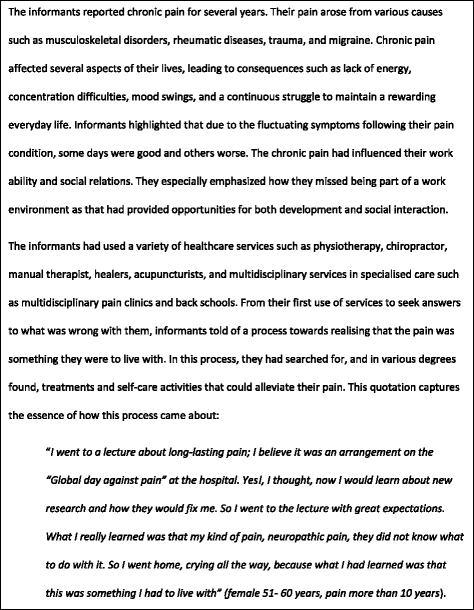Expectations towards participation in easily accessible pain management interventions: a qualitative study
- PMID: 29126444
- PMCID: PMC5681789
- DOI: 10.1186/s12913-017-2668-3
Expectations towards participation in easily accessible pain management interventions: a qualitative study
Abstract
Background: People with chronic pain use a range of healthcare services, but they also report a high degree of dissatisfaction with treatments. One reason for dissatisfaction might be participants' expectations towards treatments. The aim of this study was to explore expectations of people with chronic pain towards participation in easily accessible pain management interventions delivered in public primary care.
Methods: A qualitative study using semi-structured individual face-to-face interviews with 21 informants. The informants were recruited among participants enrolled in a randomised controlled trial on the effect of an easily accessible self-management course for people with chronic pain. The data were analysed thematically using Systematic Text Condensation.
Results: Having experienced pain for a long time, there was no specific expectation of a cure or a significant alleviation of the pain. The informants' expectations mainly concerned a hope that participation could lead to a better everyday life. The informants said that hope was important as it motivated them to keep going and continue self-care activities. The hope acted as a driving force towards trying new interventions and maintaining motivation to do activities they experienced as beneficial. Both concrete aspects of the current intervention and an understanding of what interventions in general could offer contributed to the informants hope. The expectations centred about the interventions being something new, as they had not previously tried this service, an opportunity to gain and reinforce skills, to help them continue to grow as a person, to meet others in similar situations, and to access professional support in an easy manner. Participating in interventions provided by healthcare services was seen by some as an act of self-care, where they did something active to manage their health.
Conclusions: Expectations towards the interventions were related to a hope for participation leading to a better everyday life. The role of hope for peoples' motivation to self-care implies that service providers should be aware of and help to maintain hope for a better everyday life. The importance of social support as part of self-care should be acknowledged when developing interventions targeting chronic pain.
Trial registration: ClinicalTrials.gov: NCT02531282 . Registered on August 21 2015.
Keywords: Chronic pain; Expectation; Health services accessibility; Primary health care; Qualitative research; Self-care.
Conflict of interest statement
Ethics approval and consent to participate
All informants signed an informed consent form after having received oral and written information to enable them to make an informed choice about participation. Those who participated in the qualitative study in addition to the RCT signed an additional consent form regarding the interviews. The informants were informed that participation in the qualitative study was voluntary and not a pre-requisite to trial participation. The trial has obtained approval from the director for health and social affairs in the municipality, and from the Regional Committee for Medical and Health Research Ethics (REK) (2015/ 1030/ REK sørøst).
Consent for publication
Not applicable
Competing interests
The authors declare that they have no competing interests.
Publisher’s Note
Springer Nature remains neutral with regard to jurisdictional claims in published maps and institutional affiliations.
Figures
Similar articles
-
Twelve-month effect of chronic pain self-management intervention delivered in an easily accessible primary healthcare service - a randomised controlled trial.BMC Health Serv Res. 2018 Dec 29;18(1):1012. doi: 10.1186/s12913-018-3843-x. BMC Health Serv Res. 2018. PMID: 30594190 Free PMC article. Clinical Trial.
-
Expectations, effect and experiences of an easily accessible self-management intervention for people with chronic pain: study protocol for a randomised controlled trial with embedded qualitative study.Trials. 2016 Jul 18;17(1):325. doi: 10.1186/s13063-016-1462-6. Trials. 2016. PMID: 27430319 Free PMC article. Clinical Trial.
-
Short-term effect of a chronic pain self-management intervention delivered by an easily accessible primary healthcare service: a randomised controlled trial.BMJ Open. 2018 Dec 9;8(12):e023017. doi: 10.1136/bmjopen-2018-023017. BMJ Open. 2018. PMID: 30530580 Free PMC article. Clinical Trial.
-
Systematically searching for and assessing the literature for self-management of chronic pain: a lay users' perspective.BMC Geriatr. 2014 Jul 27;14:86. doi: 10.1186/1471-2318-14-86. BMC Geriatr. 2014. PMID: 25064208 Free PMC article. Review.
-
Toward the development of a motivational model of pain self-management.J Pain. 2003 Nov;4(9):477-92. doi: 10.1016/s1526-5900(03)00779-x. J Pain. 2003. PMID: 14636816 Review.
Cited by
-
Perspectives on Creating a Chronic Pain Support Line in Portugal: Results of a Focus Group Study among Patients and Healthcare Professionals.J Clin Med. 2024 Sep 2;13(17):5207. doi: 10.3390/jcm13175207. J Clin Med. 2024. PMID: 39274420 Free PMC article.
-
Twelve-month effect of chronic pain self-management intervention delivered in an easily accessible primary healthcare service - a randomised controlled trial.BMC Health Serv Res. 2018 Dec 29;18(1):1012. doi: 10.1186/s12913-018-3843-x. BMC Health Serv Res. 2018. PMID: 30594190 Free PMC article. Clinical Trial.
-
'A lifebuoy' and 'a waste of time': patients' varying experiences of multidisciplinary pain centre treatment- a qualitative study.BMC Health Serv Res. 2019 Dec 30;19(1):1015. doi: 10.1186/s12913-019-4876-5. BMC Health Serv Res. 2019. PMID: 31888620 Free PMC article.
-
Patients and healthcare professionals perspectives on creating a chronic pain support line in Portugal: A qualitative study protocol.PLoS One. 2022 Aug 17;17(8):e0273213. doi: 10.1371/journal.pone.0273213. eCollection 2022. PLoS One. 2022. PMID: 35976966 Free PMC article.
-
Health care providers' experiences of pain management and attitudes towards digitally supported self-management interventions for chronic pain: a qualitative study.BMC Health Serv Res. 2021 Mar 25;21(1):275. doi: 10.1186/s12913-021-06278-7. BMC Health Serv Res. 2021. PMID: 33766028 Free PMC article. Clinical Trial.
References
MeSH terms
Associated data
Grants and funding
LinkOut - more resources
Full Text Sources
Other Literature Sources
Medical


